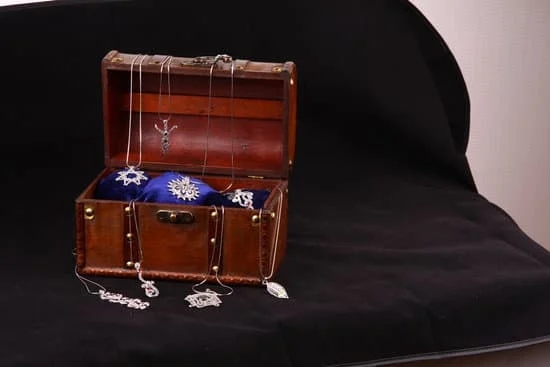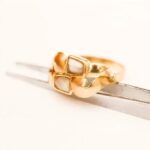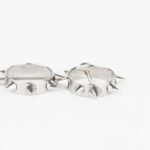Fine jewelry holds a special place in the fashion industry, revered for its exquisite craftsmanship and exceptional quality. Whether it’s a dazzling diamond necklace, a pair of intricately designed earrings, or a stunning gemstone ring, fine jewelry is prized for its timeless appeal and luxurious allure. In this section, we will delve into the world of fine jewelry, clarifying what exactly qualifies as fine jewelry and exploring its significance in the realm of fashion.
As we embark on this journey to define fine jewelry, it is essential to understand its broader context within the fashion industry. Fine jewelry represents a pinnacle of elegance and sophistication, capturing the essence of luxury like no other accessory can.
Its creation requires not only exceptional skill but also an intricate understanding of materials, design principles, and artistic vision. With each piece telling a unique story, fine jewelry becomes not just an adornment but an embodiment of artistry and expression.
Throughout history, fine jewelry has been cherished by different cultures and civilizations for millennia. It has adorned the necks of queens, graced the hands of emperors, and symbolized love and devotion across generations.
From ancient Egypt to Renaissance Europe to modern-day society, the allure of fine jewelry remains constant. This section will take you on a journey through time as we explore the origins of fine jewelry, highlighting key historical periods that have influenced its design and shedding light on how it has evolved over centuries.
Join us as we unravel the mysteries surrounding what is considered fine jewelry and discover why it continues to captivate hearts around the world. Through examining criteria for determining fine jewelry and exploring different types within this category – from rings to necklaces to bracelets – we will gain insight into this exclusive world of glamour and prestige. Get ready to embark on an exploration that celebrates craftsmanship, beauty, and the timeless charm of fine jewelry.
History of Fine Jewelry
The history of fine jewelry is a rich tapestry that spans across ancient civilizations and continues to evolve in contemporary times. This section will delve into the origins of fine jewelry, highlighting key historical periods and their influence on design, as well as exploring how fine jewelry has evolved over time.
Ancient Beginnings
Fine jewelry can trace its roots back to ancient civilizations such as Egypt, Mesopotamia, and China. In these societies, jewelry held immense cultural significance and was often associated with power, wealth, and spirituality. The Egyptians, for example, adorned themselves with elaborate gold necklaces, bracelets, rings, and amulets that represented their social status and served as protective talismans in the afterlife.
During the Renaissance period in Europe, fine jewelry took on new forms inspired by classical art and mythology. Intricate gold filigree work became popular, showcasing delicate designs incorporating floral motifs and mythological creatures like griffins and dragons. Gemstones were also highly prized during this time, adding color and brilliance to pieces.
The Influence of Art Movements
Art movements throughout history have greatly influenced the design aesthetic of fine jewelry. The Victorian era saw a resurgence of sentimentality with sentimental lockets containing locks of hair or miniature portraits. Art Nouveau brought organic forms inspired by nature into vogue with curves reminiscent of flowers and insects. In contrast, Art Deco embraced geometric shapes and bold lines that reflected the modernity of the 1920s and 1930s.
Evolution into Contemporary Designs
In recent decades, contemporary designers have continued to push boundaries with innovative materials, unconventional techniques, and avant-garde concepts. Fine jewelry has become more accessible to a wider range of consumers through fashion-forward collaborations between renowned jewelers and luxury brands.
From its humble beginnings in ancient civilizations to the bold experimentation of modern designers, the history of fine jewelry is a testament to human creativity and the enduring allure of adornment.
Criteria for Determining Fine Jewelry
Determining what qualifies as fine jewelry involves a careful assessment of several factors. These criteria play a crucial role in establishing the quality and value of a piece. When it comes to fine jewelry, materials, craftsmanship, and exclusivity are key factors to consider.
Materials are one of the primary indicators of fine jewelry. Precious metals such as gold, platinum, and silver are commonly used in fine jewelry pieces. The purity and rarity of these metals contribute to the value and desirability of the jewelry. Additionally, gemstones have a significant impact on determining whether a piece is considered fine jewelry. High-quality gemstones like diamonds, emeralds, and rubies are often featured in these pieces.
Craftsmanship is another important criterion for evaluating fine jewelry. The level of skill and precision involved in creating the piece can greatly affect its value and appeal. Attention to detail, intricate designs, and superior craftsmanship are all aspects that set fine jewelry apart from other types of accessories.
Exclusivity is also highly valued in the world of fine jewelry. Limited production runs or one-of-a-kind pieces add to their desirability and ensure their status as luxury items. Fine jewelers carefully curate their collections to maintain an air of exclusivity and elegance.
| Criteria | Description |
|---|---|
| Materials | Precious metals such as gold, platinum, silver; high-quality gemstones like diamonds |
| Craftsmanship | Attention to detail, intricate designs, superior skill and precision |
| Exclusivity | Limited production runs or one-of-a-kind pieces |
Different Types of Fine Jewelry
Fine jewelry encompasses a wide range of categories, each defined by its unique design and purpose. From rings to necklaces, bracelets to earrings, these different types of fine jewelry offer endless options for personal expression and style. Whether you prefer vintage-inspired pieces or contemporary designs, there is something for every taste within the world of fine jewelry.
Rings are one of the most popular types of fine jewelry and are often seen as symbols of love and commitment. From engagement rings to anniversary bands, rings can feature a variety of gemstones such as diamonds, sapphires, or emeralds. They can also be crafted from precious metals like gold or platinum, adding to their value and durability.
Necklaces are another versatile type of fine jewelry. They can be worn as statement pieces or subtle accents and come in various lengths and styles. Pendant necklaces feature a charm or pendant hanging from a chain, while choker necklaces sit higher on the neck for a bold look. Longer necklaces can be layered or worn alone for an elegant touch.
Bracelets offer an opportunity to adorn the wrists with style and sophistication. Tennis bracelets are classic favorites that consist of a line of diamonds or other gemstones set in a continuous band. Bangle bracelets are solid cuffs that can be worn singly or stacked for added impact. Charm bracelets allow for personalization with special trinkets that hold sentimental value.
Earrings provide an easy way to frame the face and add a touch of glamour to any look. Stud earrings are timeless classics that feature simple settings with single solitaire diamonds or other gemstones. Hoop earrings come in various sizes and shapes, from small huggie hoops to larger statement hoops. Drop earrings dangle below the earlobe and can range from delicate and understated to bold and dramatic.
Iconic Fine Jewelry Brands
When it comes to fine jewelry, certain brands have stood the test of time and continue to capture the hearts of jewelry enthusiasts worldwide. These renowned brands have made a significant impact in the industry with their unique designs, impeccable craftsmanship, and rich brand heritage. Let’s take a closer look at some of these iconic fine jewelry brands and discover what sets them apart.
Tiffany & Co.
Tiffany & Co. is synonymous with luxury and timeless elegance. Established in 1837, this American jewelry brand has become an icon through its exquisite diamonds, sterling silver creations, and signature blue boxes. From classic engagement rings to stunning diamond necklaces, Tiffany & Co. has consistently captured the imaginations of individuals seeking refined and sophisticated pieces.
Cartier
Founded in Paris in 1847, Cartier is known for its bold and innovative designs that have graced royalty, celebrities, and fashion-forward individuals for decades. Cartier’s creations exemplify exceptional craftsmanship combined with artistic flair. From the iconic “Love” bracelet to the breathtaking “Panther” collection, Cartier continues to amaze with its striking pieces that effortlessly merge tradition with modernity.
Bulgari
Bulgari is an Italian luxury brand recognized worldwide for its bold style and flamboyant aesthetic inspired by ancient Rome. Established in 1884, Bulgari employs vivid colored gemstones along with intricate metalwork to create truly extraordinary pieces. With a reputation for daring design choices and constant innovation, Bulgari remains at the forefront of high-end jewelry.
These iconic fine jewelry brands are just a few examples of the countless names that have left an indelible mark on the industry throughout history. Each brand brings its own unique vision and expertise that resonates with consumers seeking exceptional quality and design.
Whether you’re investing in a statement piece or searching for the perfect gift, exploring the collections of these renowned brands is sure to inspire and ignite a passion for fine jewelry.
Investment Value of Fine Jewelry
Introduction to the Investment Value of Fine Jewelry
Fine jewelry not only serves as a fashion statement but can also be a valuable investment. While many people are drawn to the beauty and craftsmanship of these pieces, it is important to recognize that they can also appreciate in value over time. This section will explore the investment potential of fine jewelry, including factors that contribute to its value appreciation and tips for building a fine jewelry collection as an investment strategy.
Factors Influencing Investment Value
Several key factors contribute to the investment value of fine jewelry. One of the most significant aspects is the quality of materials used in its creation. Fine jewelry often incorporates precious gemstones, such as diamonds, rubies, emeralds, or sapphires, which can substantially increase a piece’s worth. The rarity and quality of these gemstones play a crucial role in determining their market value.
Craftsmanship is another vital factor influencing the investment value of fine jewelry. Pieces created by skilled artisans with meticulous attention to detail tend to hold their value better over time. A flawlessly crafted piece can be appreciated not only for its aesthetic appeal but also for its superior workmanship, making it more desirable and valuable in the eyes of collectors.
Brand reputation and heritage can significantly impact the investment potential of fine jewelry. Established brands known for their exceptional craftsmanship and unique designs tend to hold their value well. Collectors often seek out pieces from renowned brands with long-standing histories in the industry.
Building a Fine Jewelry Collection as an Investment Strategy
For those interested in building a fine jewelry collection as an investment strategy, there are several considerations to keep in mind. Diversification is key when investing in any asset class, including fine jewelry. It is crucial to acquire pieces across various categories and styles to mitigate risk and improve liquidity.
Additionally, research plays an essential role in building a successful fine jewelry collection. Studying market trends, attending auctions and exhibitions, and consulting with experts can provide valuable insights into the potential value appreciation of specific pieces or collections.
Lastly, proper storage and insurance are crucial for protecting and preserving the investment value of fine jewelry. A secure location with controlled temperature and humidity conditions is essential to prevent damage. Obtaining comprehensive insurance coverage specifically tailored for fine jewelry investments is also advisable to protect against loss or theft.
Investing in fine jewelry not only allows individuals to enjoy the beauty and prestige of these pieces but also provides an opportunity for potential financial gain over time. By understanding the factors that contribute to the investment value of fine jewelry and following a strategic approach to collecting, investors can embrace the allure of these iconic treasures while potentially reaping long-term benefits.
Choosing Fine Jewelry for Different Occasions
When it comes to choosing fine jewelry for different occasions, it is important to consider the event, your outfit, and your personal style. Whether you are attending a formal gala or a casual gathering with friends, the right piece of jewelry can enhance your overall look and make a statement. Here are some tips to help you select the appropriate fine jewelry for various events and occasions:
- Weddings: For weddings, it is essential to strike the right balance between elegance and subtlety. Opt for delicate pieces such as a pair of diamond stud earrings, a slim gold bangle, or a simple pendant necklace. These understated accessories will complement your wedding attire without overpowering it.
- Parties: When attending parties or social events, you can be more adventurous with your choice of fine jewelry. Consider statement pieces like chandelier earrings, cocktail rings with vibrant gemstones, or layered necklaces for a glamorous touch. These bold accessories will add flair to your ensemble and ensure that all eyes are on you.
- Everyday Wear: Fine jewelry can also be worn on a daily basis to elevate your everyday outfits. Classic pieces like diamond stud earrings, dainty bracelets, or simple pendant necklaces are perfect for adding subtle elegance to your casual looks. These timeless accessories can be effortlessly paired with jeans and a t-shirt or even a tailored suit.
Remember that while selecting fine jewelry for different occasions, it is crucial to choose pieces that resonate with your personal style and reflect your individuality. Ultimately, the goal is to enhance your overall look and feel confident in what you are wearing. So whether you opt for classic elegance or bold statements, let your personality shine through in the fine jewelry you choose.
Care and Maintenance of Fine Jewelry
Taking proper care of fine jewelry is essential to ensure its longevity and maintain its beauty. With the right techniques and routine maintenance, you can keep your precious pieces looking stunning for years to come. This section will provide you with essential tips on how to care for and maintain your fine jewelry.
Firstly, it’s important to handle your fine jewelry with care. Avoid touching the gemstones directly as the oils from your skin can affect their brilliance over time. Instead, hold the piece by its metal settings or use gloves while handling. Additionally, it’s best to remove your fine jewelry before engaging in any strenuous activities or household chores that may expose it to potential damage or chemicals.
Proper storage is another crucial aspect of maintaining your fine jewelry. When not wearing them, store your pieces in separate compartments of a jewelry box or a soft fabric pouch, away from moisture and direct sunlight. This will prevent them from getting scratched or tangled with other pieces. Furthermore, be mindful of any specific storage requirements for certain gemstones or metals – some may require extra precautions due to their sensitivity.
Regular cleaning is vital for keeping your fine jewelry looking its best. However, it’s important to use gentle methods that won’t harm the piece. Avoid using harsh chemicals or abrasive materials that could damage the metal or gemstones.
Instead, opt for mild soap or specialized jewelry cleaning solutions along with a soft brush specifically designed for jewelry cleaning. Gently scrub the surfaces to remove dirt and debris, then rinse thoroughly with lukewarm water before patting dry with a clean cloth.
In addition to routine cleaning, professional maintenance is also recommended for fine jewelry. It is advised to have your pieces inspected by a reputable jeweler at least once a year who can check for loose stones, damaged prongs, or any underlying issues that may need attention.
By following these care and maintenance guidelines, you can preserve the beauty and quality of your fine jewelry for generations to come. Treat your pieces with the care they deserve, and they will continue to bring you joy and elegance throughout the years.
Conclusion
In conclusion, fine jewelry holds an enduring charm that continues to captivate individuals across generations. Throughout history, fine jewelry has evolved and adapted to reflect the styles and tastes of different eras, yet its timeless appeal remains unchanged. From ancient civilizations to contemporary designs, fine jewelry has always been associated with elegance, prestige, and the expression of personal style.
Determining what qualifies as fine jewelry involves considering various criteria such as materials, craftsmanship, and exclusivity. The use of high-quality gemstones and precious metals further enhances the value and desirability of these pieces. Whether it is a vintage ring, a bespoke necklace, or a contemporary bracelet, each type of fine jewelry carries its own significance and adds a touch of sophistication to any outfit.
Recognizing the importance of iconic brands in the world of fine jewelry is essential. These brands have established themselves through their unique designs, impeccable craftsmanship, and rich brand heritage. They have created pieces that have become cultural symbols, cherished by collectors around the globe.
Moreover, it is worth noting that fine jewelry holds investment potential due to factors such as rarity and quality craftsmanship. Building a collection can be seen not only as a way to express personal style but also as an investment strategy for future appreciation in value.
When choosing fine jewelry for different occasions, it is crucial to consider the event’s nature and one’s personal style. Fine jewelry can elevate any ensemble and leave a lasting impression when selected thoughtfully.
Finally, taking proper care of fine jewelry ensures that its timeless beauty endures for years to come. Regular cleaning techniques and routine maintenance are essential in preserving the sparkle and brilliance of these exquisite pieces.
Frequently Asked Questions
What types of jewelry are fine jewelry?
Fine jewelry refers to high-quality pieces that are crafted from precious metals such as gold, platinum, or silver, and adorned with genuine gemstones or diamonds. Examples of fine jewelry include engagement rings, wedding bands, necklaces, bracelets, earrings, and brooches. These pieces are usually made using exquisite craftsmanship and are designed to be long-lasting and heirloom-worthy.
What is considered semi fine jewelry?
Semi-fine jewelry occupies a space between fine jewelry and fashion jewelry. It is often made using less expensive materials compared to fine jewelry but still maintains a higher level of quality compared to fashion jewelry. Semi-fine jewelry may incorporate materials such as sterling silver, vermeil (gold-plated silver), or gold-filled components.
It can be adorned with semi-precious gemstones or cubic zirconia instead of rare or precious stones found in fine jewelry. While semi-fine jewelry may not carry the same high price tag as fine jewelry, it still offers an elevated level of design and durability.
Is sterling silver considered fine jewelry?
Sterling silver can be considered fine jewelry depending on various factors such as its craftsmanship, design intricacy, and the overall quality of the piece. Sterling silver consists of 92.5% pure silver alloyed with 7.5% of other metals for added strength and durability.
Many esteemed jewelers offer sterling silver pieces that feature intricate detailing, unique designs, or are embellished with gemstones or diamonds – all characteristics commonly associated with fine jewelry. However, it’s important to note that not all sterling silver jewelry falls into the category of fine jewelry; some simpler designs or mass-produced pieces may be considered more on par with fashion or costume jewelry rather than true fine jewelry.

Welcome to my jewelry blog! My name is Sarah and I am the owner of this blog.
I love making jewelry and sharing my creations with others.
So whether you’re someone who loves wearing jewelry yourself or simply enjoys learning about it, be sure to check out my blog for insightful posts on everything related to this exciting topic!





